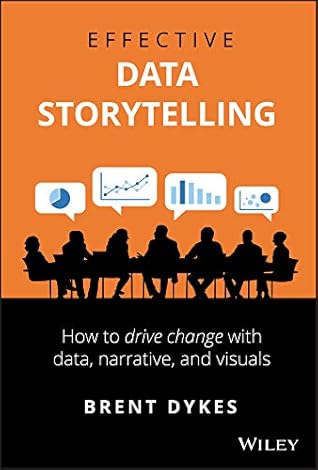More on this book
Kindle Notes & Highlights
by
Brent Dykes
Started reading
December 11, 2022
Information is giving out; communication is getting through.” Both approaches involve a sender (analyst) and a receiver (audience).
When you inform someone, you’re simply disseminating data in a passive, clinical manner. You expect the audience to interpret and comprehend the data for themselves.
When you communicate, you become an active, discernible participant in the delivery of the information rather than being a removed, neutral one if you are simply informing.
Where informing strives to connect with just the head, communicating seeks to touch the mind and heart.
To convey your insights in an effective manner that influences decisions and drives action, you must embrace the familiar yet powerful approach of storytelling.
the first step in any change process is to create a sense of urgency that helps people understand why a change is necessary
Storytelling can further amplify the power of your numbers, providing an engaging narrative that connects the dots for your audience and compels them to act.
psychology and neuroscience research reveals emotion plays a more powerful role than logic and reason in decision making.
While storytelling is commonly associated with entertainment, stories served a more foundational purpose for human society—learning.
The researchers found people responded better to identifiable victims than statistical ones.
While stories clearly dominate statistics from both a memorability and persuasiveness perspective, it’s rarely a battle between facts and anecdotes—or even facts and other facts. The real clash is actually between stories: the prevailing incumbent and a new challenger.
When your insight runs into resistance, it is because the new information you’re sharing challenges or disrupts the prevailing story in your audience’s minds.
“You can’t beat a story with fact. You can only beat it with a better story”
Understanding your intended audience’s existing narrative about a topic should inform how you position your new insight.
Rather than seeing stories and statistics as two competing forces, it’s better to seek confluence between them.
Data storytelling involves the skillful combination of three key elements: data, narrative, and visuals.
data should serve as the foundation for the narrative and visual elements of your story.
When narrative is coupled with data, it helps to explain to your audience what’s happening in the data and why a particular insight is important.
The narrative element adds structure to the data
When visuals are applied to data, they can enlighten the audience to insights that they wouldn’t see without charts or graphs.
when narrative and visuals are merged together, they can engage or even entertain an audience.
a good story is what holds our attention and transports us to other places and perspectives.
Essentially, data storytelling is a form of persuasion.
a data story closely aligns to each of Aristotle’s appeals, making it one of the most powerful forms of communication available to us.
All that an insight can offer is potential value. There’s no guarantee that an insight will deliver on its promise when it is acted on.
Even when an insight fails to reach its full potential, you still gain additional knowledge from taking action, which may eventually lead a related enhancement in the future.
At the first, basic level, you want your insight to catch and hold the attention of your audience.
The strength of how you communicate an insight can be measured by what effect it has on your audience.
On its own, data often doesn’t possess the inherent strength needed to be more than just noise—let alone to drive action. Without the right context and explanation, it can easily be misunderstood, forgotten, or dismissed.
It’s estimated more than 50% of the brain is focused on processing visual stimuli—outpacing the processing spent on our other four senses combined
multiple researchers have since confirmed the Picture Superiority Effect, in which pictures are more easily recalled than words.
They found data charts to be persuasive when an individual didn’t already possess a strong opposing opinion.
One of the traps that analytical people fall into is the assumption that decisions are shaped primarily by logic and reason.
a common misconception known as the information deficit model, where an audience is simply lacking the information they need to fully understand a problem.
Even though analytical people like to pretend emotion can be checked or removed from decision making, it’s always present and a highly influential aspect of the process.
Damásio found emotion actually assists the reasoning process and plays an essential role in helping our brains to navigate through alternatives and arrive at timely decisions.
The foremost concern of the intuitive mind is to assemble the different pieces of data it receives into unified, coherent stories.
Incorrect or missing information will not impede our brain’s attempts at jumping to conclusions and seeking to assemble coherent narratives.
Rather than simply trying to correct facts, this study shows we must help an audience to assemble a plausible story with the new data.
When key information is discounted or disproven, people will revert to the original narrative if it offers them more coherence.
When we receive new evidence that aligns with our current viewpoint, we are less skeptical and more accepting of it.
However, when we encounter facts that challenge our current beliefs or knowledge, our System 2 engages, and we become more critical and suspicious of the new data.
Just as our System 1 alerts us to potential danger when we hear a potential intruder in the house or encounter an animal in the wild, our brain can view counterevidence as a similarly imposing threat. In these cases, our mind is prepared to defend itself from conflicting information that could disrupt or harm our belief system.


